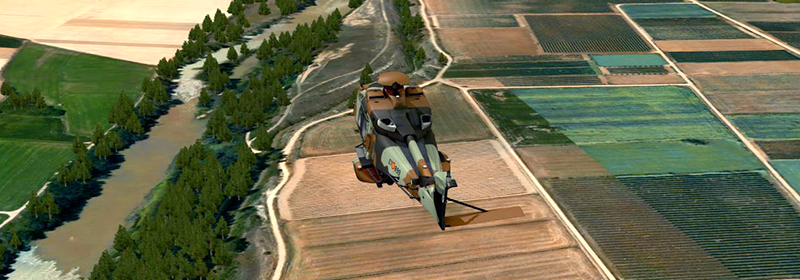- Since its opening in 2003, the center has become one of the most advanced and technologically cutting-edge simulation centers in Europe thanks to Indra’s systems
- The Spanish Army and Indra have expanded the frontiers of simulation so that pilots can be trained in the same way they operate in real missions
- Last October, the Helicopter Simulation Center (CESIHEL) was strengthened with one of the most advanced helicopter simulators that Indra has ever developed: the NH90

The CESIHEL of the Spanish Army Aviation Academy (ACAVIET) has reached 50,000 flight hours with the cutting-edge simulators developed by Indra, one of the main global technology and consulting companies and world-leader in the defence market.
This is a center that has grown progressively since its opening in 2003 to become one of the most advanced in Europe.
It has simulators of the Chinook, Cougar, Tiger and EC135 helicopter models and, since last October, also the most advanced simulator of the NH90 helicopter, the most sophisticated simulator Indra has developed for a helicopter to date.
One of the distinctive features that distinguish this center from other similar ones is that it is distributed in three different bases, located in Colmenar Viejo (Madrid), Almagro (Castile - La Mancha) and Agoncillo (La Rioja).
All the simulators are connected by a high-level architecture (HLA) that enables them to exchange encrypted data.
In this way, pilots can share the same virtual scenario and prepare their missions jointly, regardless of how far apart they may be.
This is a key feature, which makes tactical training in complex missions possible, while allowing pilots to train on the same base where the real aircraft is located. This streamlines the training and makes it much more convenient.
For Indra's Helicopters Simulation Director, José Sánchez Corbera, the Army's vision has always been "to ensure that the pilots are trained in the same way they operate in the real missions in which they participate".
Tactical training
To meet this demand, Indra has been working for over a decade to expand the frontiers of simulation and synthetically replicate not only the aircraft performance, but especially the tactical environment in which operations are carried out.
In these virtual scenarios, pilots have to react quickly to the actions of other aircraft and platforms, either friendly or hostile. Some of them are controlled by fellow pilots, while others are replicated synthetically and directed by a computer.
To defend themselves, the pilots rely on the aircraft's electronic defence systems, as they would in a real mission, which tell them if the enemy has detected their presence or if a missile has targeted them.
They must also prove their skills in stealth and evasive flying, flying at low altitudes and evading anti-aircraft fire. “This type of exercise significantly improves the pilots' coordination and decision-making, two key factors for the success of any mission”, explains José Sánchez Corbera.
They are also critical abilities for operating with pilots and units from allied countries, in multinational environments, as Spanish pilots have had to do in the ex-Yugoslavia, Iraq, Afghanistan, and Mali.
In recent years, the Spanish Army has had a strong commitment to simulation as a complement to real pilot training, which means significant savings in fuel, armament and maintenance.
A model for elite pilots all over the world
Pilots from NATO and the rest of the world have been trained at CESIHEL's facilities, in addition to civilian pilots, who are attracted by the state-of-the-art systems and technology.
Indra sells the excess hours that the Spanish Army does not use. This contributes to covering the maintenance costs of the systems and increases CESIHEL’s efficiency.
Simulator training is a growing business, motivated by the need to train top-level pilots quickly, ensuring in this way the level of operability required by armies.
Moreover, military helicopters are becoming increasingly complex and have the capability to execute a greater amount of missions. This forces pilots to prepare for a much wider range of operations, such as air assault, escort or attack operations.
Simulation has also helped to increase the crews' safety, by reinforcing training in risky operations, such as emergencies or flights in complicated areas or conditions (meteorological, tactical, environmental...). Only by using the most advanced technology can a pilot keep their skills at the highest level.
About Indra
Indra (www.indracompany.com) is one of the leading global technology and consulting companies and the technological partner for core business operations of its customers world-wide. It is a world-leader in providing proprietary solutions in specific segments in Transport and Defence markets, and a leading firm in Digital Transformation Consultancy and Information Technologies in Spain and Latin America through its affiliate Minsait. Its business model is based on a comprehensive range of proprietary products, with a high-value focus and with a high innovation component. In the 2018 financial year, Indra achieved revenue of €3.104 billion, with 43,000 employees, a local presence in 46 countries and business operations in over 140 countries.